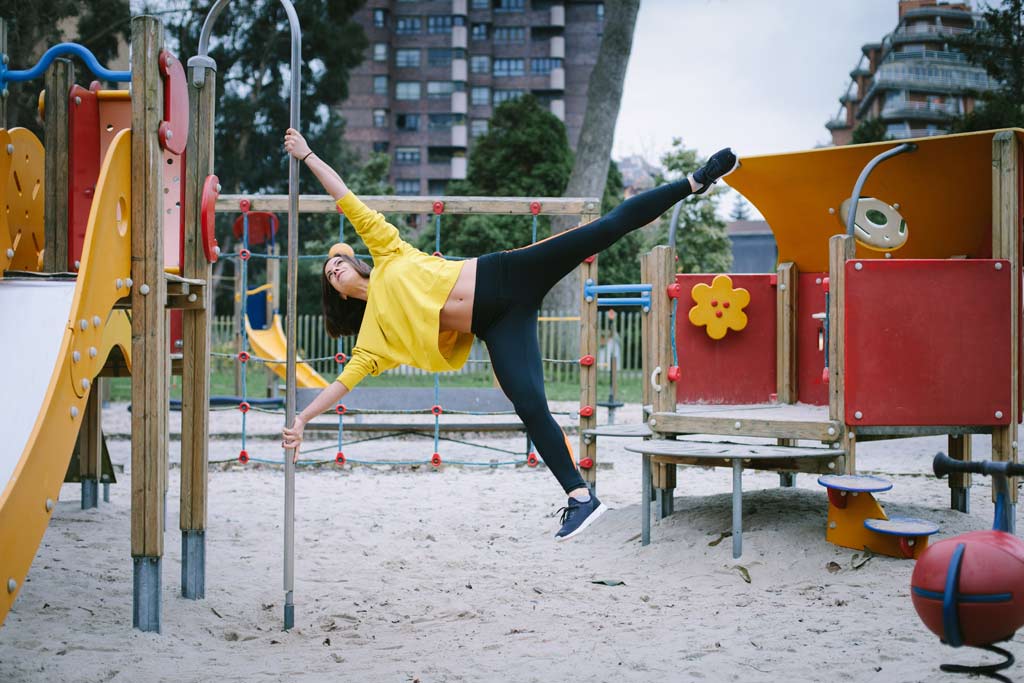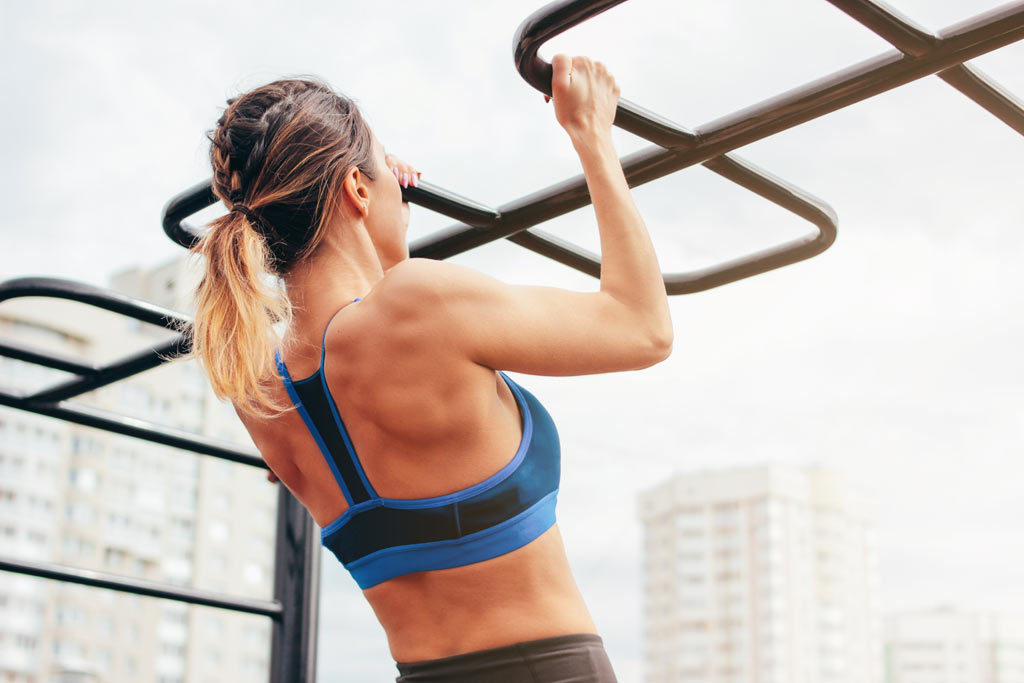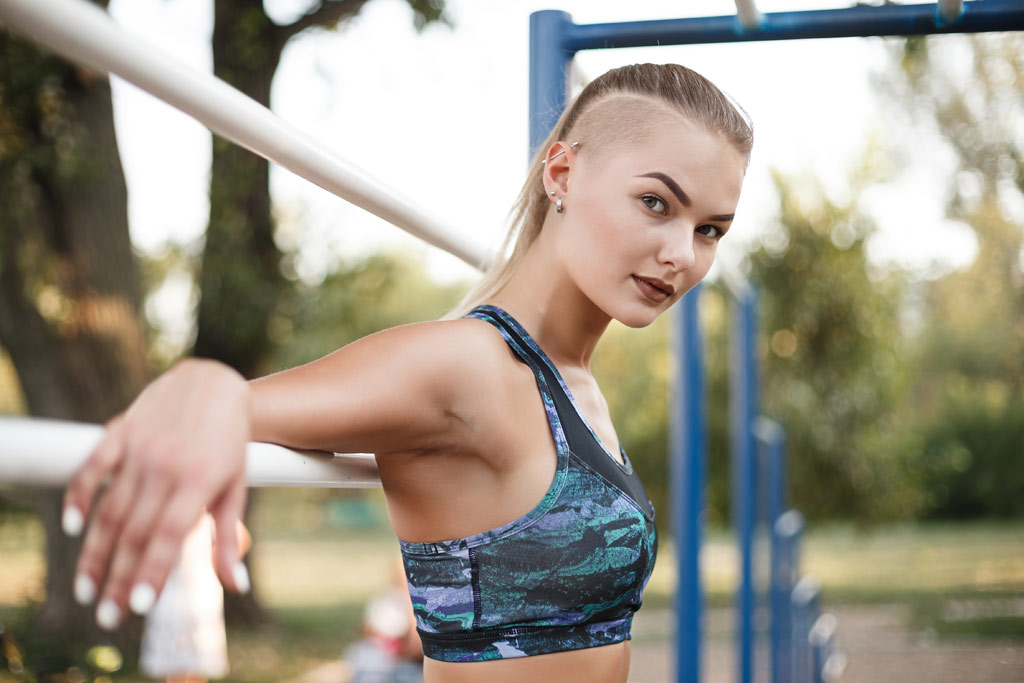From gaining incredible strength to keeping your joints limber and uninjured, the reasons why calisthenics bodyweight training should be added to your workout program are too good to pass up.
What is calisthenics anyway?

The weird thing about calisthenics is that it sounds both too easy and too hard.
There was a book in my childhood home titled “Calisthenics,” with a leotarded, fluffy-haired woman in silhouette. I think she was in a “V” position on the floor with leg warmers and jazz shoes. Inside were a list of instructions on home exercises that you could perform without equipment. They probably used the word “tone” a lot.
In the other extreme, you have the muscled bar workout dudes (I say dudes because they usually are, but props to the women in these movements). They walk shirtless in urban parks, performing movements that are something like improvised gymnastics, usually involving lots of muscle-ups and crazy push-ups with fancy French names.
“Calisthenics” describes both workout movements. What they have in common is both use bodyweight only for resistance. According to Wikipedia:
“The word calisthenics comes from the ancient Greek words kállos (κάλλος), which means “beauty” (to emphasize the aesthetic pleasure that derives from the perfection of the human body), and sthenos (σθένος), meaning “strength” (great mental strength, courage, strength, and determination). It is the art of using one’s body weight as resistance in order to develop physique.”
Wikipedia
Is there a difference between calisthenics and bodyweight training?
I usually use “calisthenics” and “bodyweight” or “bodyweight training” interchangeably, but there is a difference. It’s almost like calisthenics is to bodyweight training as music is to sound. While calisthenics is a type of bodyweight training, it’s approached as an art, with an aim to produce something beautiful. The goal is usually perfection of a movement or pose in itself, and the physical effects are secondary.
This is the true beauty of calisthenics and workouts like it: The progression is skill-based, which can make working out more specific and fulfilling, but less straightforward than weighted resistance training.
It’s also possible to get incredibly strong, and even massive, from bodyweight training alone.
What do the studies say about strength training from bodyweight?
Everyone has their opinions, and you’ll find plenty of information about how to train for strength, hypertrophy (size) or endurance. The traditional opinion is that high weight and low reps are best for strength, low weight and high reps train best for endurance, and a moderate amount of reps and weight are the sweet spot for hypertrophy training.
However, studies show that this thinking is probably wrong, or at least incomplete. Training with a higher number of reps (and thus lower weight) can be just as effective in building muscle mass as with fewer reps. In training for strength, the results are more varied. While a recent study showed that higher reps can possibly be as effective in building strength, overall research shows that traditional thinking is best. In other words, to be better at lifting heavier things, lift heavy things.
Regardless, what qualifies as “strength” varies. What qualifies as strength in a study is usually based on specific movements. It doesn’t necessarily translate to real-world strength.
Bodyweight will be mostly high-rep exercises. But not for everything.
Why am I going on about high-rep vs. low-rep? Because without added weight, most bodyweight exercises will require a higher rep count to reach fatigue. And when I say “higher rep,” I’m talking possibly hundreds of reps.
This isn’t true for everything, of course. With bodyweight exercises, the maximum weight lifted is always the same: your body weight. However, the larger muscles will have an easier time lifting, and those muscles are in the lower body. If it’s easier, you need higher reps to approach failure. While total failure isn’t necessary to build muscle, you want to at least approach it to move forward in your training. In other words, it shouldn’t be a walk in the park.
So, exercises such as squats and lunges will require a higher rep count, but upper body exercises like push-ups, pike push-ups, dips and especially pull-ups and muscle-ups won’t require many reps at all. You might not even be able to perform them—yet, anyway.
Calisthenics has some of the hardest and most impressive exercises to aspire to.

It’s rare you’ll see a gym bro bust out a muscle up or a front lever, and most of them probably can’t. Just because someone can lift a gazillion pounds on the pull-down machine does not mean they can do pull-ups.
That’s because pull-ups require a lot more than just brute strength. You could have the strongest lats in the world, but without the careful coordination of your muscles and support from your core, you won’t be able to do them. Like… not even one.
(And to defend the gym bros, most don’t even want to do pull-ups; I’m just making a point. If you want to be good at something, do that. Practice that. Practice pull-ups if you want to be able to do pull-ups. Lift heavy weights if you want to lift heavy weights. And if you want to do both, do both! You’ll have a well-rounded and functional body.)
If you haven’t yet, check out some online calisthenics resources like Al Kavadlo or Barstarzz. The feats of physical control and strength aren’t dissimilar from gymnastics or aerial dance forms, and reaching the heights of calisthenics is extremely difficult. To even approach it requires extraordinary strength, discipline and devotion.
And bodyweight training is great for beginners.
So while calisthenics bodyweight training offers some of the most difficult feats in strength training (in my humble opinion, anyway), it also provides fantastic options for those beginning their fitness journeys.
Having no added weight means you can focus on form. This will not only help you gain strength and ability faster, it will also prevent you from getting injured. You’ll be performing the motion in the least stressful way possible as well as strengthening connective tissues and smaller muscles so you don’t tweak something out of joint.
This is why calisthenics is also fantastic for those in a rehabilitative path. If you’ve suffered injury of any kind, calisthenics will be a gentle introduction (or re-introduction) to strength training.
Calisthenics equipment.
While bodyweight training doesn’t use weights, it still uses equipment. However, not every exercise needs anything more than the ground.
Bars: pull-up, high bar, low bar, parallel bars and variations.

The most common piece of equipment is a bar. If you’re invested in calisthenics in the long run, you’ll want to find a bar at your gym, outside or inside. You want one that you can hang from to perform pull-ups and hanging leg raises, and you want space above it in case you want to move to muscle-ups. And if you want to try levers, make sure there’s enough room all around it.
You can also do straight dips on such a bar, though a lower one is preferable. This is also good for Aussie pull-ups, or down-unders. Parallel bars or a dip station (or what I used to use—a walker) are great for traditional dips and Aussie pull-ups as well.
Step it up: steps, chairs, ledges, benches, blocks.
Probably the most used tool in my inventory is some kind of step or ledge, and at varying heights. This can usually be something in your environment. I use my couch for thrusts and bulgarian jumps, something a little higher like a chair for step-ups, and something a bit lower for deficit lunges or elevated push-ups.
Instability tools.
You can also make use of instability tools like a balance ball or a medicine ball (used as a surface, not a weight), TRX bands, rings or a bosu ball. Be sure to read up on the right and wrong way to stability train. Furniture sliders are another a great tool to add intensity or core work to exercises.
Walls or anything vertical.
A wall can be a great piece of equipment to help with handstands or handstand push-ups, or even to perform highly elevated exercises against, like mountain climbers.
Vive la resistance: non-weighted resistance.
Lastly, you can use resistance bands to really amp up bodyweight training, though you could say it’s cheating a bit. I mean, you’re not adding weight, but you are adding resistance. I use bands around my legs frequently to activate my glutes more for specific exercises, and occasionally to add resistance to the upper body. There are also larger bands you can use for squats, thrusts, presses and many other movements.
Why I personally love calisthenics.
About 13 years ago I came across aerial silks. I was mesmerized, and looked up classes immediately. The only problem was that I couldn’t do anything because I lacked upper body strength. When I realized that mastering pull-ups would allow me to perform the moves I wanted, I installed a bar at home and diligently practiced.
Once I could do one pull-up, something clicked. It’s almost like riding a bike; your body needs to learn how to do it, and then it doesn’t forget.
Then another few years passed, and I was in another rut. I had given up aerial training (not because of interest but lack of time and resources) and was doing metabolic resistance training, but lacked passion. Then I found Al Kavadlo and how much you could do with bodyweight training. I was hooked.
It was almost addictive. It felt great, it kept me lean and strong, kept my creativity alert and it gave me bragging rights. In fact, it wasn’t until I got in yet another rut, finding Hannah Eden, that I switched back to weights. Now, I enjoy doing both bodyweight and weighted workouts. And even the weighted workouts I do contain a good number of calisthenics exercises in them.
Progression with calisthenics.
Progression is necessary in order to gain size, strength or endurance, and the effort produced will burn calories, too. The body is incredibly adaptive, so when you introduce a stress on the system, such as a heavy object, the body adjusts to be able to carry that heavy object. The muscle breaks down and rebuilds stronger.
When you’re training with weights, progression is simple. When you need more intensity, you add more weight.
With bodyweight, you need to get creative to increase difficulty. I have a whole post on bodyweight progressions, but some of the basic ways are performing the exercise on one arm, leg, or side (whichever is relevant), adding plyometrics (jumping), adding pulses, adding isometrics, or changing the angle of the exercise.
The best routine has a place for calisthenics.
Do you need to do calisthenics all the time? No. Again, it depends on what your goals are. But a workout regimen including some calisthenics and bodyweight exercises and workouts is always optimal. Why? Because calisthenics has a lot of amazing benefits, many of which we’ve already covered.
9 good reasons to incorporate calisthenics bodyweight training into your fitness program.

1. Calisthenics workouts travel easily.
You can not only easily exercise on vacation, but you can roll up almost anywhere and work out. It’s almost a superpower in itself.
2. Calisthenics keeps you lean.
The high number of reps add a lot of cardiovascular benefits, burning a lot of calories. On top of that, strength training and any intensity you’re adding will jack up your metabolism even more.
Calisthenics is a nice all-in-one package that achieves what many call a “toned” look. Despite the misinformation about “toning” muscles, the result is the same: a lean and lithe build.
3. You build more functional strength.
Some roll their eyes at the term “functional strength,” but it’s no joke. I was moving apartments with just my husband and a couple of tweens, and we had a short window to move. I had been working out with calisthenics pretty consistently and found that moving the furniture was so much easier than before. Because calisthenics requires coordinating the entire body, it’s easier to adapt to real-world weight-carrying situations.
4. You’re less likely to get injured.
Without added weights, which alter the body’s regular center of gravity, you’re more likely to keep good form and not injure yourself. You’ll also build strength and endurance on your connective tissues and stabilizing muscles, giving you great agility and functional strength. It will help prevent you from getting injured when performing weighted exercises, as well.
5. Work your stabilizing muscles for optimal balance and agility.
The nature of calisthenics means that the harder exercises always require some balance or agility to perform. Whether it’s on one leg (pistol squat), one arm (one arm push-up), from hanging (pull-up), or require movement of your entire body through space (dragon flag), the body moves as one unit. This means that you’re not just working the major muscle groups, but the smaller stabilizing muscles as well. You’re also fine-tuning your full-body coordination.
Pro tip: Use minimalist or barefoot shoes to get an even better understanding of your body and its center of gravity.
6. Your engagement increases with a skill-based workout.
Because you’re working towards specific skills, it’s easier to get excited about working out. You’re gaining something for all that work. And engagement is crucial for long-term success.
7. It’s a creative progression.
Sure, it’s nice to be able to add more weight, but calisthenics progressions are so much more fun. Finding the steps from a back lunge to a pistol squat, for instance, require a variety of slightly non-linear moves. While there are suggested progressions (mine is here), only you can find your unique path to your desired outcome.
8. Calisthenics can get you super jacked (if that’s what you want.)
I know, probably most of my readers aren’t psyched about getting super jacked. But isn’t it nice to know that you could? And that it’s a legitimate form of strength training like traditional weight lifting programs? (Check out bodyweight supersets for a great format to fast track your bodyweight strength.)
9. It looks hella impressive!
It always feels good to roll up to the park pull-up bar and bust out a few. I can only imagine what it must feel like to hold a free-standing handstand or human flag, but I know it impresses me when I see it.
Why calisthenics is an important component of any fitness regimen.
No matter what you’re doing, your body adjusts to it. Variety is key to any well-rounded regimen to keep your body constantly stretching a bit out of its comfort zone. Only then can you make strides physically, and you might just find something that sparks your interest.
If you need something new, try a bodyweight routine. See if you can achieve a goal, like a specific movement. If you’re liking your current weightlifting program, incorporate calisthenics now and then to make sure you’re staying agile. As you increase weights, it will insure you against injury, while teaching you some new skills as well.
Here is my library of bodyweight workouts on the blog, and I’m always adding to it. If a workout looks too intense, you can always modify down.
Happy workouting!
Related calisthenics posts:
- How to Do a Pistol Squat | Progression and Alternatives
- Learn to Do a Pull-Up (Yes, It’s Possible)
- Bodyweight Supersets: The Fast Track to Bodyweight Strength
- 11 Ways to Make Exercises Harder (Without Adding Weight)
- This 35 Minute HIIT Workout Will Make You Fall in Love With Bodyweight

